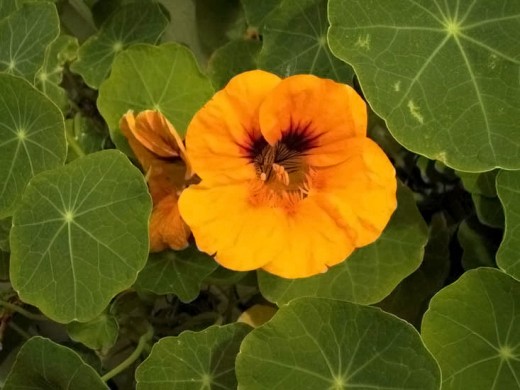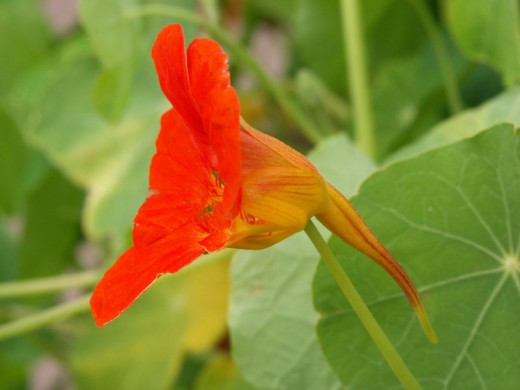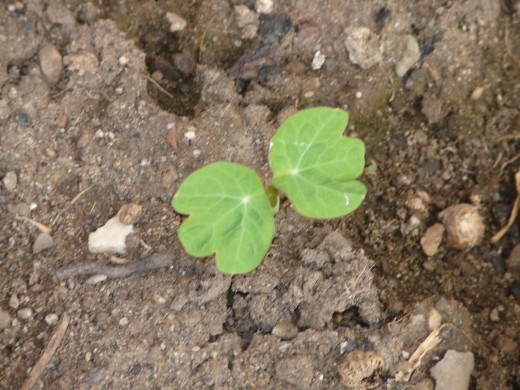What are the Benefits of Nasturtium
Where did Nasturtium Originate
Nasturtium is Latin for "nose twister" it is from the family of flowering plants called Tropaeolum which is also Latin and means "trophy."
It is a distinctly South American plant also recognized as a wildflower. Despite it's showy good looks and beautiful leaves it is a very good "weed" in that it will grow with sporadic rain and limited watering. In fact when sowing the seeds of the Nasturtium it is suggested that they be watered once after planting and not again for ten (10) days. For that reason it is a very good flowering plant for areas with water shortages, rationing, or limited rainfall.
The Nasturtium will grow all over North and South America in a mild climate.
All parts of the Nasturtium are edible including the stems, leaves, flowers and seeds. It is closely related to the mustard plant so the taste is slightly peppery. The flavor of the flowers has been compared to arugula or water cress.
The seeds, if picked before falling from the plant (immature) can be pickled and make a decent caper substitute. Mature seeds can be roasted and used as a pepper substitute or eaten "out of hand."
The plant is an annual and will "automatically" reseed. It is also a good plant to use as a lure for aphids. The aphids will flock to the Nasturtium (having little effect on them) while keeping the sap suckers away from the more delicate plants.
The nectar in the flower attracts bees, butterflies and humming birds.



Nasturtium as Medicinal
Nasturtium contain vitamin(s) C, B1, B2, and B3. They also contain iron, calcium, phosphorus and manganese. The oils of the plant contain glucosinolates, carotenoids and flavionoids.All of these compounds have been shown to protect against carcinogenic agents.
These compounds are naturally occurring insect repellents as well and are also antibiotic, expectorant (producing a productive cough), and possibly anti-fungal.
Nasturtium Vinegar
Roughly chop one whole plant including leaf, stalk,
flowers, buds and seedpods and steep them in vinegar for 10 days to 14 days.
Use three tablespoons as a dressing on steamed or raw greens.
Nasturtium Tincture
As above chop one whole plant (leaf, stalks, flowers, buds, and seedpods) and weigh the result. Add double the weight of 90 proof alcohol (Vodka comes to mind) and let steep for one month.
Use 1/2 teaspoon daily as an herbal remedy for bronchitis.
Do seek a doctors advice if you intend to use either recipe instead of a prescribed drug!!!
Nasturtium as Food
Nasturtium Strawberry Salad
Ingredients
- 1 pint sliced strawberries
- 1/3 cup nasturtium blossoms
- 2 tablespoons champagne vinegar
- 2-3 tablespoons sugar
Directions
- Toss together and taste for sweetness.
- Add more sugar if necessary.
- Eat and enjoy
Nasturtium Butter
Ingredients
- 4 ounces of unsalted butter at room temperature
- 12 to 18 Nasturtium petals (from the flower of course)
- 2 to 4 fresh supple Nasturtium leaves
Directions
- Remove the individual petals and wash thoroughly in cold water. Pat dry.
- Roll the petals together into a tube and cut with a sharp knife making thin 1/8" or 1/16" strips
- Cut the strips into small squares. The object is to mince the flower petals
- Cut the butter into 8 pieces into a small bowl and with a fork mash the butter into a spreadable consistency
- Once the butter is fairly soft incorporate the minced Nasturtium by slowly blending
- With a rubber cake spatula transfer the butter to small serving bowls
- Refrigerate until serving time
Nasturtium butter can be frozen for up to two months
Other Food Uses
You can also make a "pesto" with the leaves.
Ingredients
- 2 Cups packed Nasturtium leaves (cleaned, washed, patted dry)
- 3 ~ 5 cloves of garlic
- 1 or 2 drops of hot sauce
- 1/2 Cup walnuts
- Olive oil drizzled in to make a slurry
Directions
- Combine everything but the oil in a food processor and blend
- Add oil until you get a very loose paste
Serve on toast, pasta, or dip fresh fruit into it.
Most pesto recipes call for way too much oil. Since the idea is to get a particular consistency rather than a flavor profile from the oil I always recommend drizzling until you get the desired look rather than spelling out a set amount of oil.
Where to Get Them
Any seed catalog company worth it's logo has Nasturtium seeds. One I researched sells twenty-five seeds for 99¢. They are fast growing, beautiful to look at, and good to eat. Best of all they produce so many seeds they will very likely come back on their own next season.











